Nonlinear Influence and Interaction Effect on the Imbalance of Metro-Oriented Dockless Bike-Sharing System
Abstract
:1. Introduction
- Investigated the spatial distribution of balanced/imbalanced bike usage at metro stations during morning and evening peaks.
- Discovered the important factors and their interaction strengths for six scenarios by SHAP-based method.
- Quantified the nonlinear individual effects of important factors and their pairwise interaction effects.
2. Related Work
2.1. Metro-Oriented Dockless Bike-Sharing
2.2. Imbalance of Bike-Sharing System
2.3. Interactive Effects of Factors on Bike-Sharing Usage
3. Study Area and Data
3.1. Study Area
3.2. Data Sources
4. Methodolgy
4.1. Methodological Framework
4.2. Defining the Catchment of Metro Stations for Trips between Bike-Sharing System and Metros
4.3. Defining the Study Area of the Built Environment around Each Metro Station
| Algorithm 1 Calculate the buffer radius for each station. |
|
4.4. Variables Description
4.4.1. Indicator of Dependent Variables: Access-Egress Ratio
4.4.2. Independent Variables
4.4.3. Modeling and Experiment
4.4.4. Model Interpretation Method
5. Findings and Discussions
5.1. Description and Distributions of the Imbalance
5.2. Independent Effects of Important Factors
- Road network density has a greater impact during the morning peak than during the evening peak.
- During the morning peak, road network density has a greater impact on suburban areas, while the city center is influenced to a great extent by other factors. As a result, all three types of states can occur.
- During the evening peak, lower road network density is more likely to lead to a balanced state.

5.3. The Strength of Interaction Effects for Important Factors
5.4. Interaction Effects of Important Combination
6. Conclusions and Limitations
- 1.
- The road density exceeds 12 (km/km) with a relatively high footway ratio during morning peak;
- 2.
- The highway/primary ratio exceeds 0.42 with a low footway ratio during morning peak;
- 3.
- A high shopping POIs ratio with low financial service POIs ratio during evening peak;
- 4.
- Education and culture POIs ratio is below 4 and education and culture POIs ratio exceeds 4 with higher financial service POIs ratio during the evening peak.
- 1.
- The sports and leisure POIs ratio is above 1.9 and education and culture POIs ratio is below 4 with low scenic spot POIs ratio during morning peak;
- 2.
- Healthcare POIs ratios exceed 3.5 with a lower Education and culture POIs ratio during morning peak;
- 3.
- The sports and leisure POIs ratio is below 3.5 with a lower footway ratio and the sports and leisure POIs ratio is above 3.5 with a high footway ratio during evening peak;
- 4.
- The auto service POIs ratio is below 3 with a high footway ratio and the auto service POIs ratio is above 3 with a lower footway ratio during the evening peak.
Author Contributions
Funding
Institutional Review Board Statement
Informed Consent Statement
Data Availability Statement
Conflicts of Interest
References
- Kazancoglu, Y.; Ozbiltekin-Pala, M.; Ozkan-Ozen, Y. Prediction and evaluation of greenhouse gas emissions for sustainable road transport within Europe. Sustain. Cities Soc. 2021, 70, 102924. [Google Scholar] [CrossRef]
- Chen, L.; Zhang, D.; Wang, L.; Yang, D.; Ma, X.; Li, S.; Wu, Z.; Pan, G.; Nguyen, T.M.T.; Jakubowicz, J. Dynamic cluster-based over-demand prediction in bike sharing systems. In Proceedings of the UbiComp 2016, 2016 ACM International Joint Conference on Pervasive and Ubiquitous Computing, Heidelberg, Germany, 12–16 September 2016; Association for Computing Machinery: New York, NY, USA, 2016. [Google Scholar] [CrossRef]
- Yu, Q.; Zhang, H.; Li, W.; Sui, Y.; Song, X.; Yang, D.; Shibasaki, R.; Jiang, W. Mobile phone data in urban bicycle-sharing: Market-Oriented sub-area division and spatial analysis on emission reduction potentials. J. Clean. Prod. 2020, 254, 119974. [Google Scholar] [CrossRef]
- Zhang, Y.; Mi, Z. Environmental benefits of bike sharing: A big data-based analysis. Appl. Energy 2018, 220, 296–301. [Google Scholar] [CrossRef]
- Yu, Q.; Yuan, J. TransBigData: A Python package for transportation spatio-temporal big data processing, analysis and visualization. J. Open Source Softw. 2022, 7, 4021. [Google Scholar] [CrossRef]
- Kutela, B.; Langa, N.; Mwende, S.; Kidando, E.; Kitali, A.E.; Bansal, P. A text mining approach to elicit public perception of bike-sharing systems. Travel Behav. Soc. 2021, 24, 113–123. [Google Scholar] [CrossRef]
- Lin, D.; Nelson, J.D.; Beecroft, M.; Cui, J. An overview of recent developments in China’s metro systems. Tunn. Undergr. Space Technol. 2021, 111, 103783. [Google Scholar] [CrossRef]
- Li, W.; Chen, S.; Dong, J.; Wu, J. Exploring the spatial variations of transfer distances between dockless bike-sharing systems and metros. J. Transp. Geogr. 2021, 92, 103032. [Google Scholar] [CrossRef]
- Zhao, J.; Wang, J.; Deng, W. Exploring bikesharing travel time and trip chain by gender and day of the week. Transp. Res. Part C Emerg. Technol. 2015, 58, 251–264. [Google Scholar] [CrossRef]
- Hu, S.; Chen, M.; Jiang, Y.; Sun, W.; Xiong, C. Examining factors associated with bike-and-ride (BnR) activities around metro stations in large-scale dockless bikesharing systems. J. Transp. Geogr. 2022, 98, 103271. [Google Scholar] [CrossRef]
- Ni, Y.; Chen, J. Exploring the effects of the built environment on two transfer modes for metros: Dockless bike sharing and taxis. Sustainability 2020, 12, 2034. [Google Scholar] [CrossRef]
- Handy, S.L.; Boarnet, M.G.; Ewing, R.; Killingsworth, R.E. How the built environment affects physical activity: Views from urban planning. Am. J. Prev. Med. 2002, 23 (Suppl. S1), 64–73. [Google Scholar] [CrossRef] [PubMed]
- Ding, C.; Cao, X.; Næss, P. Applying gradient boosting decision trees to examine non-linear effects of the built environment on driving distance in Oslo. Transp. Res. Part A Policy Pract. 2018, 110, 107–117. [Google Scholar] [CrossRef]
- Zheng, Z.; Zhou, S.; Deng, X. Exploring both home-based and work-based jobs-housing balance by distance decay effect. J. Transp. Geogr. 2021, 93, 103043. [Google Scholar] [CrossRef]
- Lundberg, S.M.; Allen, P.G.; Lee, S.-I. A Unified Approach to Interpreting Model Predictions. Available online: https://github.com/slundberg/shap (accessed on 10 November 2023).
- Lundberg, S.M.; Erion, G.G.; Lee, S.-I. Consistent Individualized Feature Attribution for Tree Ensembles. Available online: https://arxiv.org/abs/1802.03888v3 (accessed on 10 November 2023).
- Friedman, J.H. Greedy function approximation: A gradient boosting machine. Ann. Stat. 2001, 29, 1189–1232. [Google Scholar] [CrossRef]
- Friedman, J.; Hastie, T.; Tibshirani, R. Additive Logistic Regression: A Statistical View of Boosting. Ann. Stat. 2000, 28, 337–407. [Google Scholar] [CrossRef]
- Guo, Y.; He, S.Y. Built environment effects on the integration of dockless bike-sharing and the metro. Transp. Res. Part D Transp. Environ. 2020, 83, 102335. [Google Scholar] [CrossRef]
- Li, Z.; Shang, Y.; Zhao, G.; Yang, M. Exploring the Multiscale Relationship between the Built Environment and the Metro-Oriented Dockless Bike-Sharing Usage. Int. J. Environ. Res. Public Health 2022, 19, 2323. [Google Scholar] [CrossRef]
- Li, Y.; Zhu, Z.; Guo, X. Operating characteristics of dockless bike-sharing systems near metro stations: Case study in Nanjing City, China. Sustainability 2019, 11, 2256. [Google Scholar] [CrossRef]
- Li, X.; Du, M.; Yang, J. Factors influencing the access duration of free-floating bike sharing as a feeder mode to the metro in Shenzhen. J. Clean. Prod. 2020, 277, 123273. [Google Scholar] [CrossRef]
- Kim, K. Investigation of modal integration of bike-sharing and public transit in Seoul for the holders of 365-day passes. J. Transp. Geogr. 2023, 106, 103518. [Google Scholar] [CrossRef]
- Dong, J.; Chen, S.; Li, W.; Zhou, Y.; Si, H. Evaluation of Dockless Bike-Sharing Transfer Services around Metro Stations considering Spatial Heterogeneity. J. Adv. Transp. 2022, 2022, 7732485. [Google Scholar] [CrossRef]
- He, M.; Ma, X.; Wang, J.; Zhu, M. Geographically Weighted Multinomial Logit Models for Modelling the Spatial Heterogeneity in the Bike-Sharing Renting-Returning Imbalance: A Case Study on Nanjing, China. Sustain. Cities Soc. 2022, 83, 103967. [Google Scholar] [CrossRef]
- Xie, X.F.; Wang, Z.J. Examining travel patterns and characteristics in a bikesharing network and implications for data-driven decision supports: Case study in the Washington DC area. J. Transp. Geogr. 2018, 71, 84–102. [Google Scholar] [CrossRef]
- Bi, H.; Li, A.; Hua, M.; Zhu, H.; Ye, Z. Examining the varying influences of built environment on bike-sharing commuting: Empirical evidence from Shanghai. Transp. Policy 2022, 129, 51–65. [Google Scholar] [CrossRef]
- Gao, F.; Li, S.; Tan, Z.; Liao, S. Visualizing the Spatiotemporal Characteristics of Dockless Bike Sharing Usage in Shenzhen, China. J. Geovis. Spat. Anal. 2022, 6, 12. [Google Scholar] [CrossRef]
- Chen, Z.; van Lierop, D.; Ettema, D. Travel satisfaction with dockless bike-sharing: Trip stages, attitudes and the built environment. Transp. Res. Part D Transp. Environ. 2022, 106, 103280. [Google Scholar] [CrossRef]
- Guo, R.; Jiang, Z.; Huang, J.; Tao, J.; Wang, C.; Li, J.; Chen, L. BikeNet: Accurate bike demand prediction using graph neural networks for station rebalancing. In Proceedings of the 2019 IEEE SmartWorld, Ubiquitous Intelligence and Computing, Advanced and Trusted Computing, Scalable Computing and Communications, Internet of People and Smart City Innovation, SmartWorld/UIC/ATC/SCALCOM/IOP/SCI 2019, Leicester, UK, 19–23 August 2019; pp. 686–693. [Google Scholar] [CrossRef]
- Li, L.; Li, X.; Yu, S.; Li, X.; Dai, J. Unbalanced usage of free-floating bike sharing connecting with metro stations. Phys. A Stat. Mech. Its Appl. 2022, 608, 128245. [Google Scholar] [CrossRef]
- Zheng, Z.; Chen, Y.; Zhu, D.; Sun, H.; Wu, J.; Pan, X.; Li, D. Extreme unbalanced mobility network in bike sharing system. Phys. A Stat. Mech. Its Appl. 2021, 563, 125444. [Google Scholar] [CrossRef]
- Wang, L.; Zhou, K.; Zhang, S.; Moudon, A.V.; Wang, J.; Zhu, Y.G.; Sun, W.; Lin, J.; Tian, C.; Liu, M. Designing bike-friendly cities: Interactive effects of built environment factors on bike-sharing. Transp. Res. Part D Transp. Environ. 2023, 117, 103670. [Google Scholar] [CrossRef]
- Gao, F.; Li, S.; Tan, Z.; Wu, Z.; Zhang, X.; Huang, G.; Huang, Z. Understanding the modifiable areal unit problem in dockless bike sharing usage and exploring the interactive effects of built environment factors. Int. J. Geogr. Inf. Sci. 2021, 35, 1863410. [Google Scholar] [CrossRef]
- Gao, K.; Yang, Y.; Gil, J.; Qu, X. Data-driven interpretation on interactive and nonlinear effects of the correlated built environment on shared mobility. J. Transp. Geogr. 2023, 110, 103604. [Google Scholar] [CrossRef]
- China City Statistical Yearbook; National Bureau of Statistics of China: Beijing, China, 2021.
- Shenzhen Government Open Data Platform. Available online: https://opendata.sz.gov.cn (accessed on 10 November 2023).
- BMap API. Available online: https://lbsyun.baidu.com (accessed on 10 November 2023).
- Open Street Map. Available online: https://www.openstreetmap.org (accessed on 10 November 2023).
- Amap API Interface. Available online: https://lbs.amap.com/api/webservice/summary (accessed on 10 November 2023).
- Platform for Estate Transactions in Shenzhen. Available online: https://sz.ke.com (accessed on 10 November 2023).
- Du, Y.; Deng, F.; Liao, F. A model framework for discovering the spatio-temporal usage patterns of public free-floating bike-sharing system. Transp. Res. Part C Emerg. Technol. 2019, 103, 39–55. [Google Scholar] [CrossRef]
- Song, Y.; Merlin, L.; Rodriguez, D. Comparing measures of urban land use mix. Comput. Environ. Urban Syst. 2013, 42, 1–13. [Google Scholar] [CrossRef]
- Ke, G.; Meng, Q.; Finley, T.; Wang, T.; Chen, W.; Ma, W.; Ye, Q.; Liu, T.-Y. LightGBM: A Highly Efficient Gradient Boosting Decision Tree. Available online: https://github.com/Microsoft/LightGBM (accessed on 10 November 2023).
- Wang, C.; Wu, Q.; Weimer, M.; Zhu, E. Flaml: A Fast and Lightweight Automl Library. Available online: https://github.com/microsoft/FLAML (accessed on 10 November 2023).
- Lundberg, S.M.; Lee, S.I. A unified approach to interpreting model predictions. In Proceedings of the NIPS’17: 31st International Conference on Neural Information Processing Systems, Long Beach, CA, USA, 4–9 December 2017. [Google Scholar]
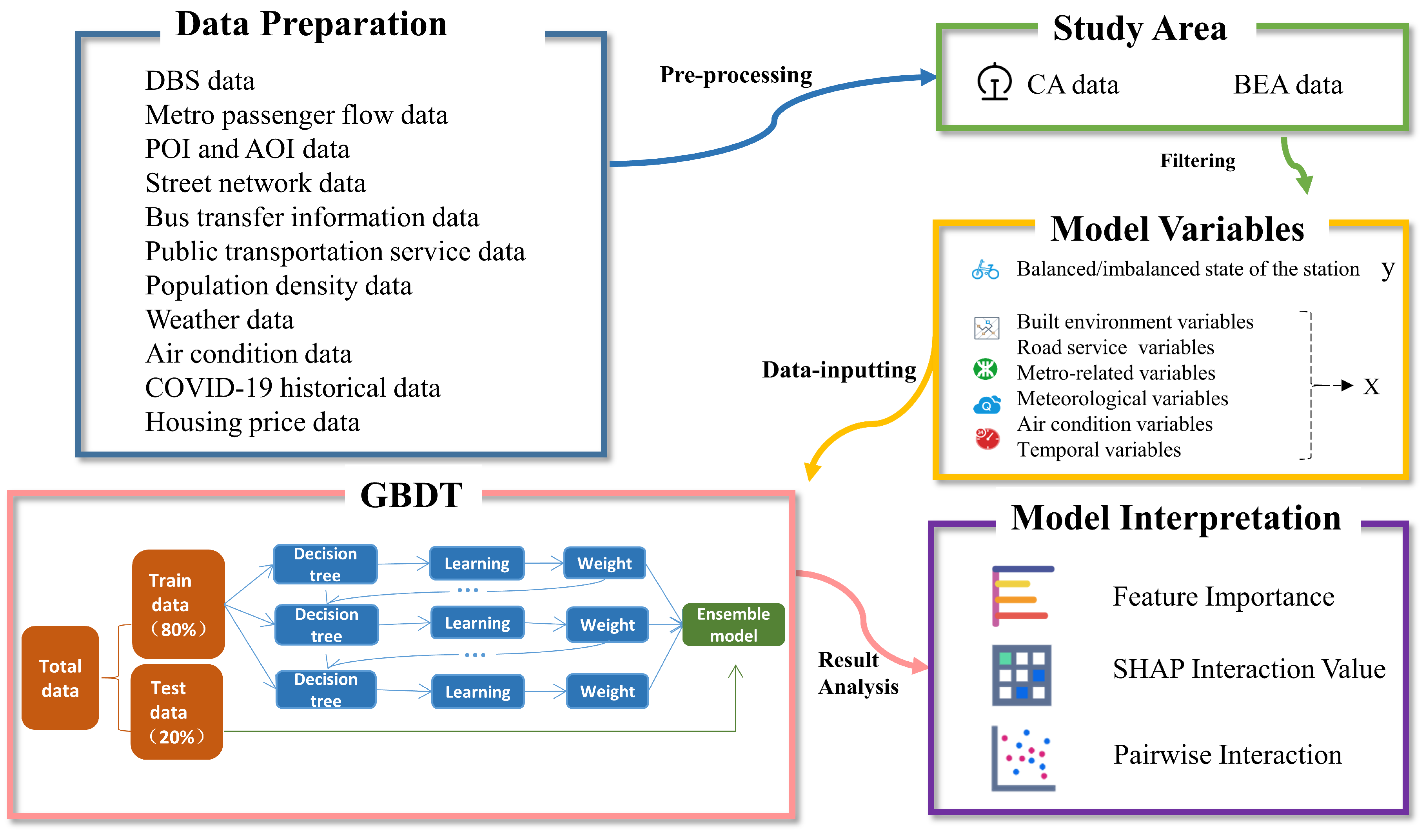


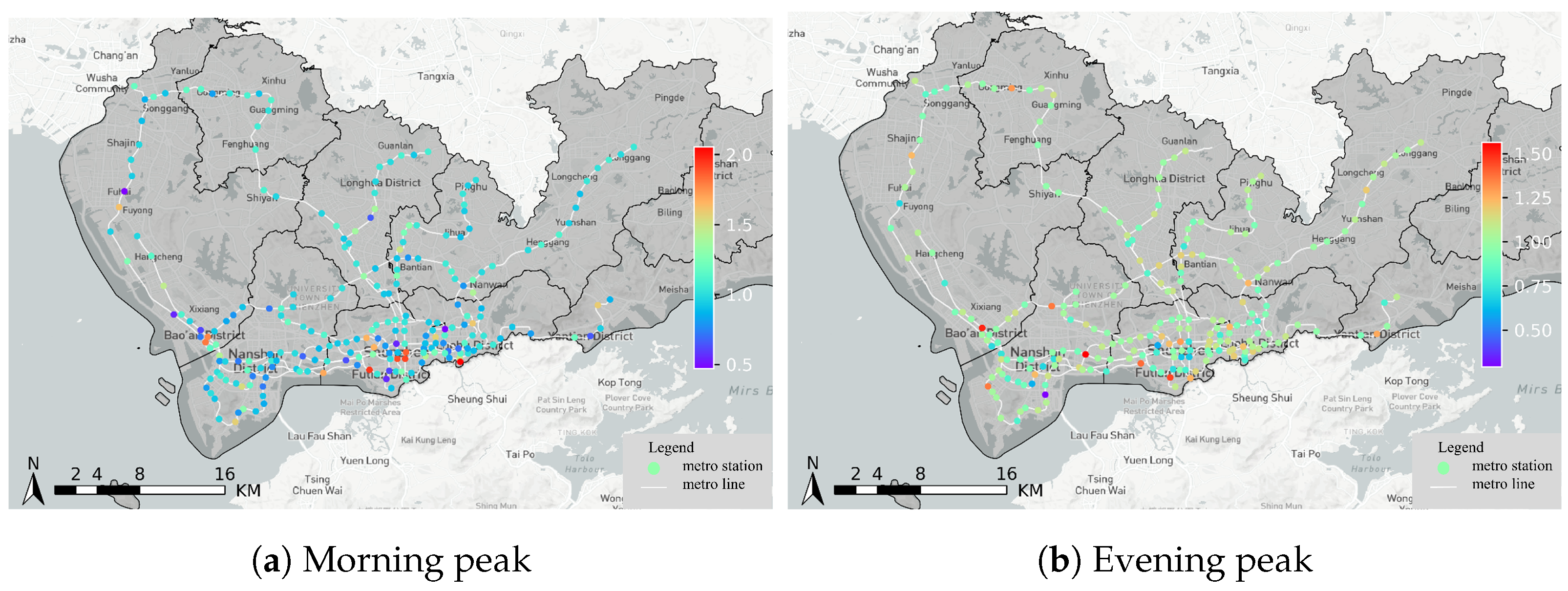
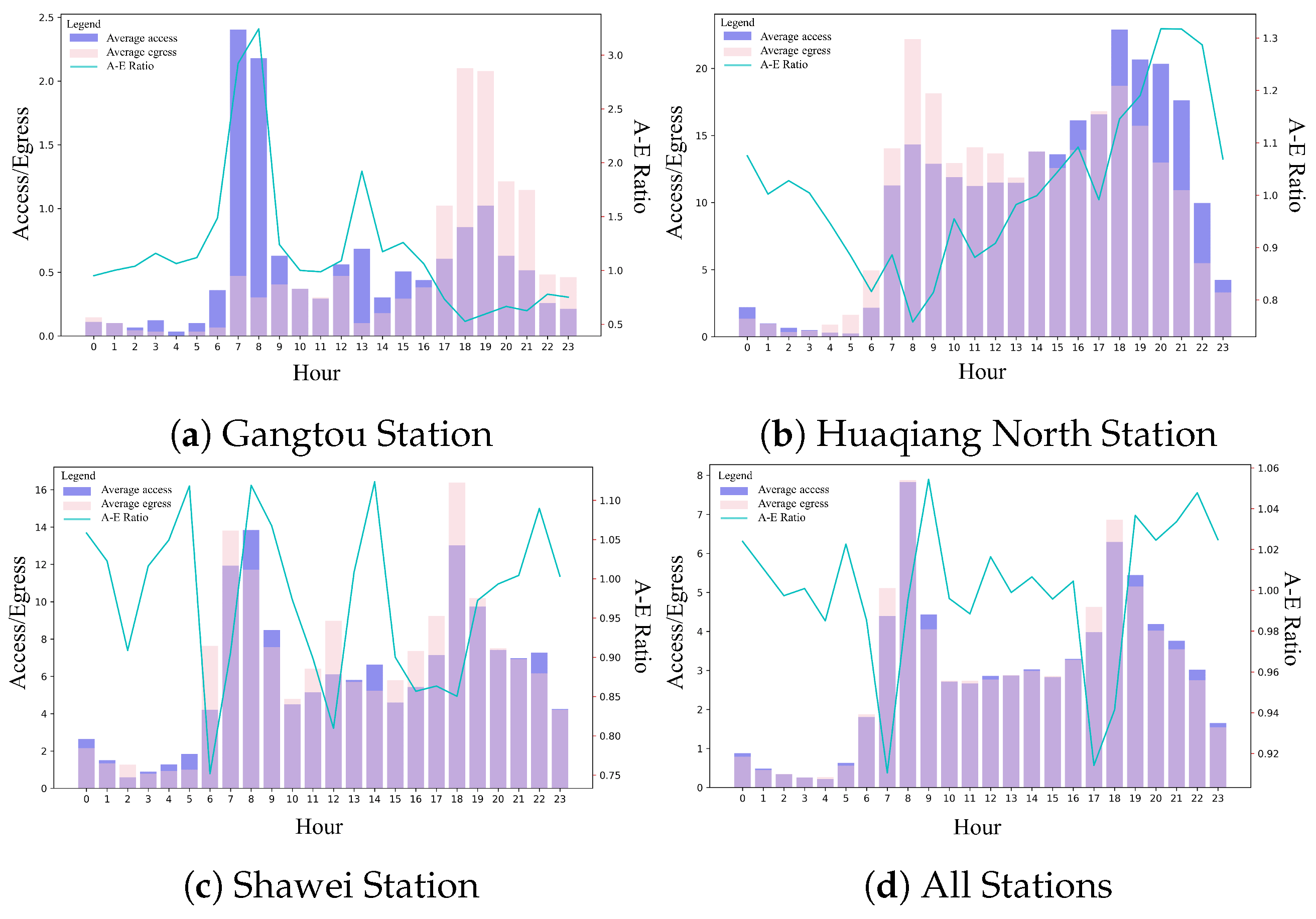
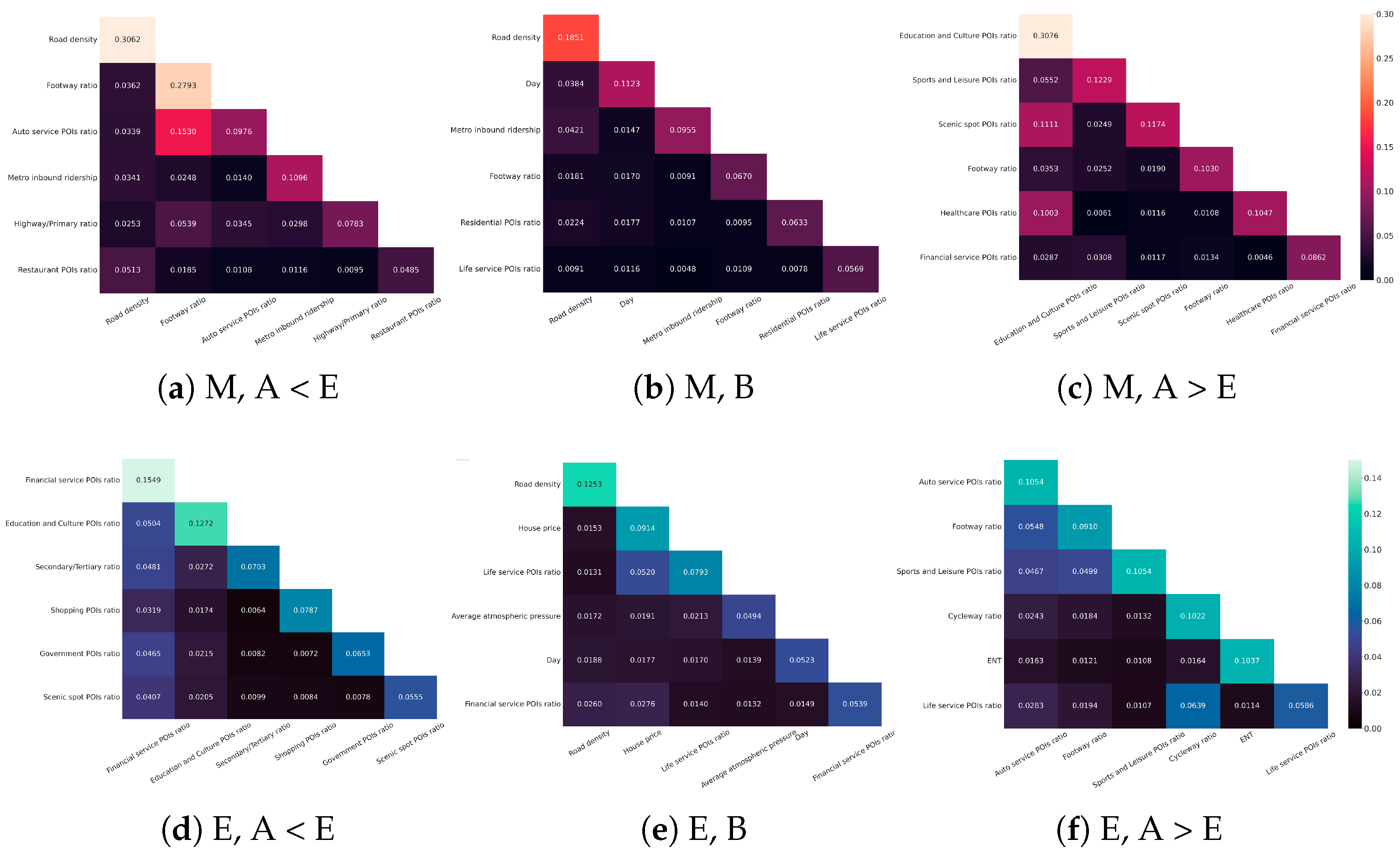

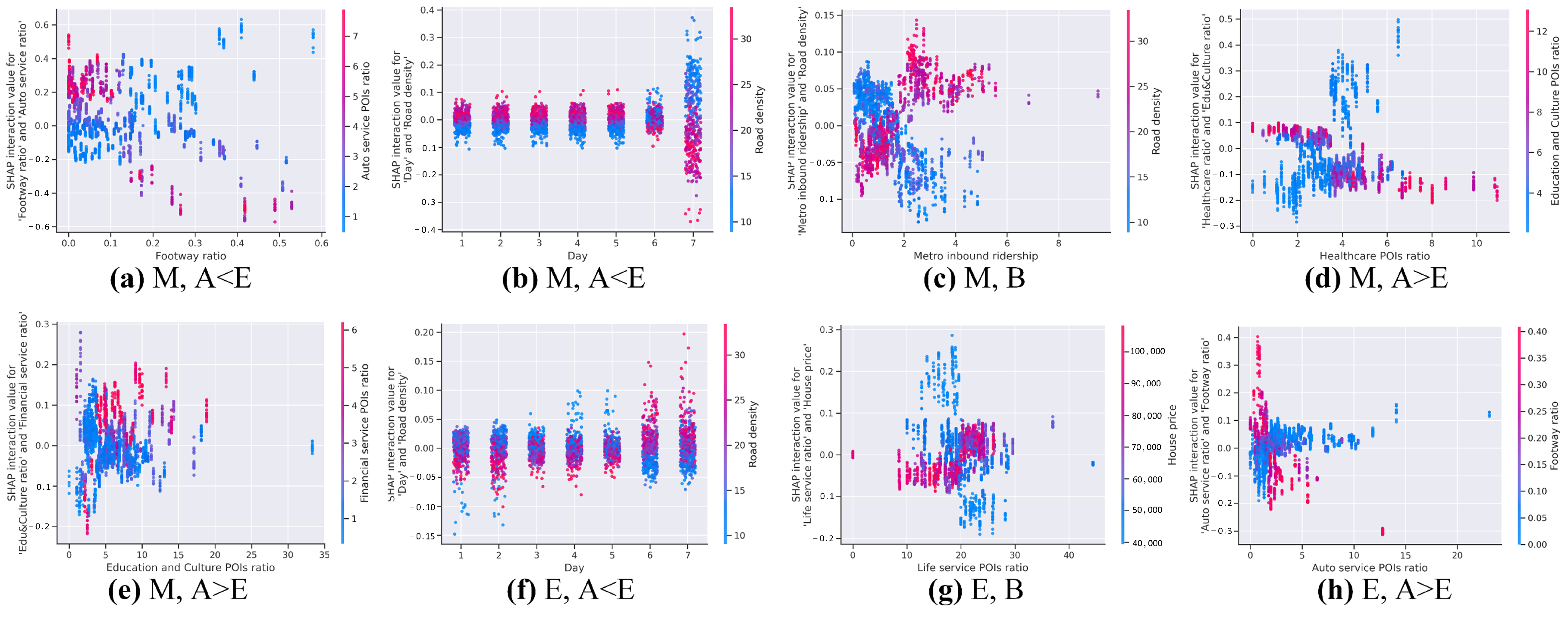
| Publication | Influencing Factors | Method | Time Scale | Dependent Variables |
|---|---|---|---|---|
| [20] | Built environment factors | MGWR model | One week | Access/egress Daily use on weekdays/weekend |
| [24] | Built environment factors, Metro station passenger flow | GWR model | One month | Average daily transfer ridership |
| [21] | Built environment factors | K-means clustering | Fourteen days | Number of bikes near station |
| [19] | Built environment factors, attributes of metro stations, and socioeconomic characteristics | Binomial regression | Three days | Access/egress-integrated use during the AM/PM peak |
| [11] | Built environment factors | SLM | One month | DBS transfer ridership/ Taxi transfer ridership |
| [8] | Built environment factors | GWR model | One week | 85th percentile transfer distance (egress)/ 85th percentile transfer distance (access) |
| [23] | Built environment factors | binomial regression | One year | Mileage-accumulated trips ratio for annual pass users |
| Our study | Built environment factors, Metro station passenger flow, Meteorological/air condition factors, temporal factors | GBDT model | Three months | Imbalanced state of the metro stations during the AM/PM peak |
| Category | Variables | Min | Max | Mean | S.D. |
|---|---|---|---|---|---|
| Land use (within BEA) | Ratio of healthcare POIs (%) | 0.465 | 10.909 | 3.617 | 1.619 |
| Ratio of workplace POIs (%) | 0.416 | 22.222 | 3.483 | 2.567 | |
| Ratio of residential POIs (%) | 0.206 | 22.222 | 4.041 | 2.355 | |
| Ratio of government POIs (%) | 0.444 | 19.231 | 3.553 | 2.674 | |
| Ratio of shopping POIs (%) | 4.688 | 57.950 | 24.130 | 9.161 | |
| Ratio of education and culture POIs (%) | 1.044 | 33.333 | 5.809 | 3.596 | |
| Ratio of scenic spot POIs (%) | 0.044 | 18.307 | 0.966 | 2.589 | |
| Ratio of sports and leisure POIs (%) | 0.379 | 8.716 | 2.656 | 1.216 | |
| Ratio of auto service POIs (%) | 0.204 | 23.100 | 3.092 | 2.717 | |
| Ratio of restaurant POIs (%) | 0.685 | 33.343 | 18.520 | 5.772 | |
| Ratio of transportation facilities POIs (%) | 1.865 | 57.895 | 9.342 | 6.248 | |
| Ratio of financial service POIs (%) | 0.204 | 18.359 | 2.041 | 2.269 | |
| Ratio of life service POIs (%) | 7.692 | 44.444 | 19.728 | 4.488 | |
| Land use mixture | 0.580 | 0.990 | 0.800 | 0.060 | |
| Population density (numbers/km) | 2308.407 | 17,668.935 | 10,499.280 | 4472.406 | |
| Average housing price (Yuan/km) | 18,164 | 135,570 | 66,196 | 21,988 | |
| Road service (within BEA) | Road density (km/km) | 1.580 | 43.700 | 18.100 | 7.650 |
| Ratio of highway/primary | 0.000 | 0.740 | 0.350 | 0.130 | |
| Ratio of secondary/tertiary | 0.110 | 1.000 | 0.520 | 0.160 | |
| Ratio of footway | 0.020 | 0.580 | 0.110 | 0.120 | |
| Ratio of cycleway | 0.000 | 0.270 | 0.020 | 0.040 | |
| Number of bus stops near the station | 0.000 | 90.000 | 22.100 | 16.800 | |
| Metro-related (Monthly average daily traffic volume) | Metro outbound ridership (million/day) | 0.070 | 6.680 | 1.490 | 1.160 |
| Metro inbound ridership (million/day) | 0.070 | 6.950 | 1.490 | 1.140 | |
| Metro interchange volume (million/day) | 0.000 | 16.500 | 0.950 | 2.660 | |
| Metro passenger volume (million/day) | 0.070 | 23.400 | 2.440 | 3.320 | |
| Metro collecting/distributing volume (million/day) | 0.150 | 13.600 | 2.980 | 2.310 | |
| Metro boarding/alighting volume (million/day) | 0.150 | 30.100 | 3.920 | 4.210 | |
| Meteorological variables | Average temperature (°C) | 23.200 | 30.600 | 28.400 | 1.450 |
| Average humidity (%) | 72.000 | 92.000 | 81.200 | 5.070 | |
| Wind speed (m/s) | 0.700 | 5.200 | 2.090 | 0.880 | |
| Average atmospheric pressure (Pa) | 98,870 | 100,750 | 99,988 | 357 | |
| Daily cumulative precipitation (mm) | 0.000 | 96.600 | 8.780 | 18.400 | |
| Precipitation of yesterday daytime (mm) | 0.000 | 57.400 | 3.600 | 8.410 | |
| Precipitation of yesterday nighttime (mm) | 0.000 | 96.100 | 5.100 | 15.800 | |
| Precipitation of today daytime (mm) | 0.000 | 57.400 | 3.680 | 8.410 | |
| Air condition | AQI | 12.300 | 80.400 | 24.400 | 9.730 |
| Temporal variables | Month | - | - | - | - |
| Day of week | - | - | - | - |
| Morning Peak Model | Evaluation Metric | ||||
|---|---|---|---|---|---|
| Accuracy | Precision | Recall | F1 Score | AUC | |
| MNL | 0.70681 | 0.54375 | 0.34899 | 0.30612 | 0.65581 |
| KNN | 0.77269 | 0.69794 | 0.65064 | 0.67119 | 0.82266 |
| Decision Tree | 0.74583 | 0.65322 | 0.65711 | 0.65511 | 0.73468 |
| RF | 0.82386 | 0.79943 | 0.68974 | 0.73163 | 0.88035 |
| GBDT | 0.83404 | 0.81981 | 0.70167 | 0.74697 | 0.91438 |
| Evening Peak Model | Evaluation Metric | ||||
| Accuracy | Precision | Recall | F1 Score | AUC | |
| MNL | 0.70476 | 0.23492 | 0.33333 | 0.27561 | 0.60981 |
| KNN | 0.68263 | 0.52707 | 0.47953 | 0.49604 | 0.69195 |
| Decision Tree | 0.65378 | 0.50345 | 0.49930 | 0.50118 | 0.61935 |
| RF | 0.74566 | 0.64561 | 0.54292 | 0.57578 | 0.79707 |
| GBDT | 0.76050 | 0.71305 | 0.51379 | 0.55563 | 0.82431 |
| Mean (|SHAP Value|) | Morning Peak Model | Evening Peak Model | ||||||
|---|---|---|---|---|---|---|---|---|
| Class1 (A < E 1) | Class2 (B 1) | Class3 (A > E) | Sum Value | Class1 (A < E) | Class2 (B) | Class3 (A > E) | Sum Value | |
| Road density | 0.310 | 0.179 | 0.063 | 0.553 | 0.042 | 0.117 | 0.092 | 0.251 |
| Footway ratio | 0.266 | 0.076 | 0.127 | 0.469 | 0.046 | 0.034 | 0.122 | 0.202 |
| Education and Culture POIs ratio | 0.072 | 0.028 | 0.356 | 0.457 | 0.144 | 0.033 | 0.054 | 0.230 |
| Metro inbound ridership | 0.107 | 0.102 | 0.029 | 0.238 | 0.044 | 0.031 | 0.033 | 0.108 |
| Scenic spot POIs ratio | 0.038 | 0.051 | 0.131 | 0.219 | 0.072 | 0.030 | 0.026 | 0.128 |
| Sports and Leisure POIs ratio | 0.036 | 0.037 | 0.136 | 0.210 | 0.061 | 0.032 | 0.113 | 0.206 |
| Auto service POIs ratio | 0.122 | 0.024 | 0.062 | 0.208 | 0.058 | 0.023 | 0.124 | 0.205 |
| Residential POIs ratio | 0.046 | 0.069 | 0.084 | 0.200 | 0.035 | 0.038 | 0.040 | 0.113 |
| Day | 0.035 | 0.119 | 0.042 | 0.196 | 0.048 | 0.059 | 0.054 | 0.160 |
| Life service POIs ratio | 0.065 | 0.025 | 0.077 | 0.183 | 0.061 | 0.088 | 0.091 | 0.240 |
| Restaurant POIs ratio | 0.020 | 0.056 | 0.088 | 0.179 | 0.065 | 0.017 | 0.039 | 0.121 |
| Healthcare POIs ratio | 0.100 | 0.036 | 0.027 | 0.176 | 0.042 | 0.035 | 0.029 | 0.106 |
| Metro passenger volume | 0.063 | 0.022 | 0.064 | 0.167 | 0.041 | 0.019 | 0.015 | 0.076 |
| Financial service POIs ratio | 0.049 | 0.041 | 0.053 | 0.164 | 0.201 | 0.050 | 0.017 | 0.268 |
| Highway/Primary ratio | 0.047 | 0.033 | 0.047 | 0.162 | 0.044 | 0.037 | 0.038 | 0.119 |
| Transportation Facilities POIs ratio | 0.053 | 0.028 | 0.032 | 0.149 | 0.069 | 0.031 | 0.037 | 0.137 |
| Average atmospheric pressure | 0.062 | 0.015 | 0.029 | 0.143 | 0.050 | 0.065 | 0.033 | 0.147 |
| Secondary/Tertiary ratio | 0.028 | 0.031 | 0.046 | 0.127 | 0.083 | 0.023 | 0.032 | 0.138 |
| House price | 0.035 | 0.035 | 0.027 | 0.113 | 0.033 | 0.100 | 0.068 | 0.200 |
| Cycleway ratio | 0.033 | 0.037 | 0.027 | 0.105 | 0.010 | 0.014 | 0.112 | 0.136 |
| Work place POIs ratio | 0.028 | 0.021 | 0.047 | 0.105 | 0.052 | 0.030 | 0.036 | 0.118 |
| AQI | 0.030 | 0.034 | 0.030 | 0.097 | 0.051 | 0.032 | 0.037 | 0.119 |
Disclaimer/Publisher’s Note: The statements, opinions and data contained in all publications are solely those of the individual author(s) and contributor(s) and not of MDPI and/or the editor(s). MDPI and/or the editor(s) disclaim responsibility for any injury to people or property resulting from any ideas, methods, instructions or products referred to in the content. |
© 2023 by the authors. Licensee MDPI, Basel, Switzerland. This article is an open access article distributed under the terms and conditions of the Creative Commons Attribution (CC BY) license (https://creativecommons.org/licenses/by/4.0/).
Share and Cite
Song, Y.; Luo, K.; Shi, Z.; Zhang, L.; Shen, Y. Nonlinear Influence and Interaction Effect on the Imbalance of Metro-Oriented Dockless Bike-Sharing System. Sustainability 2024, 16, 349. https://doi.org/10.3390/su16010349
Song Y, Luo K, Shi Z, Zhang L, Shen Y. Nonlinear Influence and Interaction Effect on the Imbalance of Metro-Oriented Dockless Bike-Sharing System. Sustainability. 2024; 16(1):349. https://doi.org/10.3390/su16010349
Chicago/Turabian StyleSong, Yancun, Kang Luo, Ziyi Shi, Long Zhang, and Yonggang Shen. 2024. "Nonlinear Influence and Interaction Effect on the Imbalance of Metro-Oriented Dockless Bike-Sharing System" Sustainability 16, no. 1: 349. https://doi.org/10.3390/su16010349
APA StyleSong, Y., Luo, K., Shi, Z., Zhang, L., & Shen, Y. (2024). Nonlinear Influence and Interaction Effect on the Imbalance of Metro-Oriented Dockless Bike-Sharing System. Sustainability, 16(1), 349. https://doi.org/10.3390/su16010349





